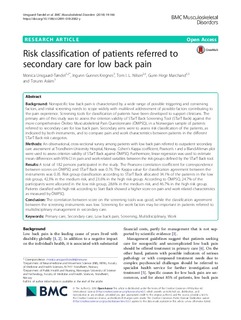| dc.contributor.author | Unsgaard-Tøndel, Monica | |
| dc.contributor.author | Kregnes, Ingunn Gunnes | |
| dc.contributor.author | Nilsen, Tom Ivar Lund | |
| dc.contributor.author | Marchand, Gunn Hege | |
| dc.contributor.author | Askim, Torunn | |
| dc.date.accessioned | 2018-07-12T10:37:31Z | |
| dc.date.available | 2018-07-12T10:37:31Z | |
| dc.date.created | 2018-05-24T20:56:03Z | |
| dc.date.issued | 2018 | |
| dc.identifier.citation | BMC Musculoskeletal Disorders. 2018, 19 (166), 1-7. | nb_NO |
| dc.identifier.issn | 1471-2474 | |
| dc.identifier.uri | http://hdl.handle.net/11250/2505225 | |
| dc.description.abstract | Background
Nonspecific low back pain is characterized by a wide range of possible triggering and conserving factors, and initial screening needs to scope widely with multilevel addressment of possible factors contributing to the pain experience. Screening tools for classification of patients have been developed to support clinicians. The primary aim of this study was to assess the criterion validity of STarT Back Screening Tool (STarT Back) against the more comprehensive Örebro Musculoskeletal Pain Questionnaire (ÖMPSQ), in a Norwegian sample of patients referred to secondary care for low back pain. Secondary aims were to assess risk classification of the patients, as indicated by both instruments, and to compare pain and work characteristics between patients in the different STarT Back risk categories.
Methods
An observational, cross-sectional survey among patients with low back pain referred to outpatient secondary care assessment at Trondheim University Hospital, Norway. Cohen’s Kappa coefficient, Pearson’s r and a Bland-Altman plot were used to assess criterion validity of STarT Back against ÖMPSQ. Furthermore, linear regression was used to estimate mean differences with 95% CI in pain and work related variables between the risk groups defined by the STarT Back tool.
Results
A total of 182 persons participated in the study. The Pearsons correlation coefficient for correspondence between scores on ÖMPSQ and STarT Back was 0.76. The Kappa value for classification agreement between the instruments was 0.35. Risk group classification according to STarT Back allocated 34.1% of the patients in the low risk group, 42.3% in the medium risk, and 23.6% in the high risk group. According to ÖMPSQ, 24.7% of the participants were allocated in the low risk group, 28.6% in the medium risk, and 46.7% in the high risk group. Patients classified with high risk according to Start Back showed a higher score on pain and work related characteristics as measured by ÖMPSQ.
Conclusion
The correlation between score on the screening tools was good, while the classification agreement between the screening instruments was low. Screening for work factors may be important in patients referred to multidisciplinary management in secondary care. | nb_NO |
| dc.language.iso | eng | nb_NO |
| dc.publisher | BioMed Central | nb_NO |
| dc.rights | Navngivelse 4.0 Internasjonal | * |
| dc.rights.uri | http://creativecommons.org/licenses/by/4.0/deed.no | * |
| dc.title | Risk classification of patients referred to secondary care for low back pain | nb_NO |
| dc.type | Journal article | nb_NO |
| dc.type | Peer reviewed | nb_NO |
| dc.description.version | publishedVersion | nb_NO |
| dc.source.pagenumber | 1-7 | nb_NO |
| dc.source.volume | 19 | nb_NO |
| dc.source.journal | BMC Musculoskeletal Disorders | nb_NO |
| dc.source.issue | 166 | nb_NO |
| dc.identifier.doi | https://doi.org/10.1186/s12891-018-2082-y | |
| dc.identifier.cristin | 1586594 | |
| dc.description.localcode | © The Author(s). 2018 Open Access This article is distributed under the terms of the Creative Commons Attribution 4.0 International License (http://creativecommons.org/licenses/by/4.0/) | nb_NO |
| cristin.unitcode | 194,65,30,0 | |
| cristin.unitcode | 194,65,20,0 | |
| cristin.unitname | Institutt for nevromedisin og bevegelsesvitenskap | |
| cristin.unitname | Institutt for samfunnsmedisin og sykepleie | |
| cristin.ispublished | true | |
| cristin.fulltext | original | |
| cristin.qualitycode | 1 | |

